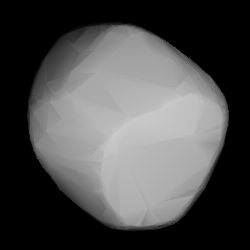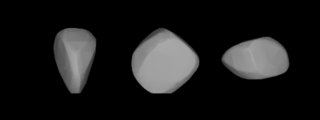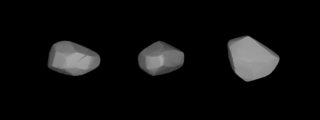Related Research Articles
3850 Peltier, provisional designation 1986 TK2, is a Florian asteroid and suspected interloper from the inner regions of the asteroid belt, approximately 4 kilometers in diameter. It was discovered on 7 October 1986, by American astronomer Edward Bowell at Lowell's Anderson Mesa Station, near Flagstaff, Arizona. The asteroid was named after American amateur astronomer Leslie Peltier.

178 Belisana is a stony background asteroid from the inner regions of the asteroid belt, approximately 38 kilometers in diameter. It was discovered on 6 November 1877, by Austrian astronomer Johann Palisa at the Austrian Naval Observatory in today's Croatia. The S-type asteroid has a rotation period of 12.32 hours and a rather spherical shape. It was named after the Celtic goddess Belisama (Belisana).
1729 Beryl, provisional designation 1963 SL, is a stony background asteroid from the Florian region in the inner asteroid belt, approximately 9 kilometers in diameter. It was discovered on 19 September 1963, by astronomers at Indiana University during the Indiana Asteroid Program at Goethe Link Observatory in Indiana, United States. The S-type asteroid has a rotation period of 4.9 hours. It was named for Beryl H. Potter, a long-time research assistant of the discovering program.

1388 Aphrodite is an asteroid of the Eos family from the outer regions of the asteroid belt, approximately 22 kilometers in diameter. It was discovered on 24 September 1935, by Belgian astronomer Eugène Delporte at the Royal Observatory of Belgium in Uccle. The likely elongated K-type asteroid has a rotation period of 11.9 hours. It was named after the Greek goddess Aphrodite from Greek mythology.
1099 Figneria, provisional designation 1928 RQ, is an asteroid from the background population of the outer regions of the asteroid belt, approximately 26 kilometers in diameter. Discovered by Grigory Neujmin at Simeiz Observatory in 1928, the asteroid was later named after Russian revolutionary activist Vera Figner.
1122 Neith, provisional designation 1928 SB, is a background asteroid from the central region of the asteroid belt, approximately 12 kilometers in diameter. It was discovered by Belgian astronomer Eugène Delporte at the Royal Observatory of Belgium in Uccle on 17 September 1928. The asteroid was named after the goddess Neith from Egyptian mythology.
12696 Camus, provisional designation 1989 SF1, is a carbonaceous background asteroid from the central region of the asteroid belt, approximately 9 kilometers in diameter.
1194 Aletta, provisional designation 1931 JG, is a carbonaceous asteroid from the outer region of the asteroid belt, approximately 55 kilometers in diameter. It was discovered on 13 May 1931, by South African astronomer Cyril Jackson at Johannesburg Observatory in South Africa. It was later named after the discoverer's wife Aletta Jackson.
5642 Bobbywilliams, provisional designation 1990 OK1, is an eccentric, stony asteroid and Mars-crosser from the inner regions of the asteroid belt, approximately 4.7 kilometers in diameter.
1240 Centenaria, provisional designation 1932 CD, is a background asteroid from the outer regions of the asteroid belt, approximately 60 kilometers in diameter. It was discovered on 5 February 1932, by astronomer Richard Schorr at the Bergedorf Observatory in Hamburg, Germany. The assumed C-type asteroid has a rotation period of 11.3 hours. It was named for the 100th anniversary of the discovering observatory.
3034 Climenhaga is a stony Florian asteroid and synchronous binary asteroid from the inner regions of the asteroid belt, approximately 7.8 kilometers in diameter. The asteroid was discovered on 24 September 1917 by German astronomer Max Wolf at Heidelberg Observatory in southwest Germany and assigned provisional designation A917 SE. It was later named after Canadian astrophysicist John Climenhaga. Its minor-planet moon has a period of nearly 19 hours.

1244 Deira is a dark background asteroid and slow rotator from the inner region of the asteroid belt. The X-type asteroid has an exceptionally long rotation period of 210.6 hours and measures approximately 31 kilometers in diameter. It was discovered on 25 May 1932, by English-born South African astronomer Cyril Jackson at the Union Observatory in Johannesburg, who named it after Deira, an old kingdom near his birthplace, the market town of Ossett, located in West Yorkshire, England.

1251 Hedera is a background asteroid from the central regions of the asteroid belt, approximately 13 kilometers in diameter. It was discovered on 25 January 1933, by German astronomer Karl Reinmuth at the Heidelberg-Königstuhl State Observatory in southwest Germany. The asteroid was named for the climbing plant Hedera, commonly known as "ivy".
4904 Makio, provisional designation 1989 WZ, is a stony asteroid from the inner regions of the asteroid belt, approximately 8 kilometers in diameter. It was discovered by Japanese astronomers Yoshikane Mizuno and Toshimasa Furuta at Kani Observatory on 21 November 1989. It was named after Japanese astronomer Makio Akiyama.

1607 Mavis, provisional designation 1950 RA, is a stony asteroid from the central region of the asteroid belt, approximately 12 kilometers in diameter. It was discovered on 3 September 1950, by South African astronomer Ernest Johnson at Johannesburg Observatory in South Africa. It was later named after the wife of astronomer Jacobus Bruwer.
1979 Sakharov, provisionally designated 2006 P-L, is a stony Vestian asteroid from the inner regions of the asteroid belt, approximately 4.5 kilometers in diameter. It was discovered during the Palomar–Leiden survey in 1960, and named after Russian physicist Andrei Sakharov.

1263 Varsavia, provisional designation 1933 FF, is an asteroid from the central region of the asteroid belt, approximately 40 kilometers in diameter. It was discovered on 23 March 1933, by Belgian astronomer Sylvain Arend at Uccle Observatory in Belgium. It is named for the city of Warsaw.
1563 Noël, provisional designation 1943 EG, is a stony Flora asteroid from the inner regions of the asteroid belt, approximately 8 kilometers in diameter. It was discovered on 7 March 1943, by Belgian astronomer Sylvain Arend at the Royal Observatory of Belgium in Uccle, and named after his son.

1449 Virtanen, provisional designation 1938 DO, is a stony Florian asteroid from the inner regions of the asteroid belt, approximately 9.2 kilometers in diameter. It was discovered on 20 February 1938, by Finnish astronomer Yrjö Väisälä at Turku Observatory in Southwest Finland, and named for Finnish biochemist Artturi Virtanen.
10208 Germanicus, provisional designation 1997 QN1, is a stony Florian asteroid and binary system from the inner regions of the asteroid belt, approximately 3.5 kilometers in diameter.
References
- 1 2 3 4 5 6 7 "4332 Milton (1983 RC)". Minor Planet Center. Retrieved 27 April 2018.
- 1 2 3 4 5 6 "JPL Small-Body Database Browser: 4332 Milton (1983 RC)" (2018-02-23 last obs.). Jet Propulsion Laboratory . Retrieved 27 April 2018.
- 1 2 "Asteroid 4332 Milton – Proper Elements". AstDyS-2, Asteroids – Dynamic Site. Retrieved 29 October 2019.
- 1 2 3 4 5 "LCDB Data for (4332) Milton". Asteroid Lightcurve Database (LCDB). Retrieved 27 April 2018.
- 1 2 3 4 Masiero, Joseph R.; Nugent, C.; Mainzer, A. K.; Wright, E. L.; Bauer, J. M.; Cutri, R. M.; et al. (October 2017). "NEOWISE Reactivation Mission Year Three: Asteroid Diameters and Albedos". The Astronomical Journal. 154 (4): 10. arXiv: 1708.09504 . Bibcode:2017AJ....154..168M. doi: 10.3847/1538-3881/aa89ec .
- 1 2 3 4 Tedesco, E. F.; Noah, P. V.; Noah, M.; Price, S. D. (October 2004). "IRAS Minor Planet Survey V6.0". NASA Planetary Data System. 12: IRAS-A-FPA-3-RDR-IMPS-V6.0. Bibcode:2004PDSS...12.....T . Retrieved 22 October 2019.
- 1 2 Kabas, Afsar (June 2016). "The synodic rotational period of asteroid 4332 Milton". Icarus. 271: 279–282. Bibcode:2016Icar..271..279K. doi:10.1016/j.icarus.2016.02.017.
- 1 2 Oey, Julian (October 2009). "Lightcurve Analysis of Asteroids from Leura and Kingsgrove Observatory in the Second Half of 2008". The Minor Planet Bulletin. 36 (4): 162–164. Bibcode:2009MPBu...36..162O. ISSN 1052-8091.
- 1 2 3 Veres, Peter; Jedicke, Robert; Fitzsimmons, Alan; Denneau, Larry; Granvik, Mikael; Bolin, Bryce; et al. (November 2015). "Absolute magnitudes and slope parameters for 250,000 asteroids observed by Pan-STARRS PS1 – Preliminary results". Icarus. 261: 34–47. arXiv: 1506.00762 . Bibcode:2015Icar..261...34V. doi:10.1016/j.icarus.2015.08.007. S2CID 53493339.
- ↑ "MPC/MPO/MPS Archive". Minor Planet Center. Retrieved 27 April 2018.